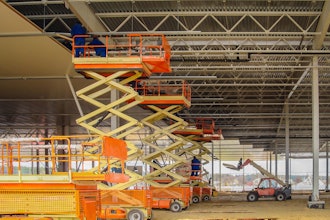DALLAS (AP) — Boeing grounded its test fleet of new 787 passenger jets on Wednesday while it investigates an electrical fire that forced one of the planes to make an emergency landing.
On Tuesday, a 787 on a 6-hour test flight had to make an emergency landing in Texas after the crew reported smoke in the rear of the plane.
Boeing said it would take several days to analyze flight data from the plane. Boeing stopped test flights for all of its 787 test planes "until we better understand the cause of the incident," it said late on Wednesday.
Boeing spokeswoman Loretta Gunter said it wasn't yet clear how long it would be until test flights resume, and that some flying could resume before the data analysis is finished.
"We don't have a schedule in mind right now," she said.
The company plans ground tests on the planes while they're not flying.
Gunter said the fire started in a power control panel in a rear electronics bay on the test plane. Boeing is inspecting the power panel and the area around it to see if other repairs are needed.
The fire cut the plane's electrical power. Boeing said backup systems including a ram air turbine — essentially a wind-powered generator — functioned as expected.
Boeing Co. shares fell $2.18, or 3.2 percent, to $67.07 on Wednesday, making it easily the worst performer in the Dow Jones industrial average.
The plane was powered by two Rolls-Royce Trent engines, but Gunter said Boeing has no reason to think the smoke came from the engines. Last week, a different model of Rolls-Royce engine on a Qantas Airbus A380 jet blew apart during a flight.
The Federal Aviation Administration is investigating Tuesday's incident, and the National Transportation Safety Board is monitoring the situation but hasn't sent investigators to the scene, a spokesman said.
This marks the latest setback for a plane that is already about three years behind schedule. Boeing had hoped to deliver the first 787, which it calls the Dreamliner, to Japan's All Nippon Airways in the first quarter of next year.
"We are committed to finding the cause quickly but will not rush the technical team in its efforts," the company said.
Nathan Smith, an aerospace analyst for Frost & Sullivan, said it's critical that Boeing put a stop to the delays on the 787 or risk losing sales to Airbus, which expects to begin shipping a rival plane, the A350, in 2013.
Smith said Boeing was paying the price for building a complex, innovative new aircraft with parts from suppliers around the world.
Assembling the plane "is like putting a jigsaw puzzle together — sometimes the pieces don't fit," Smith said. "Airbus is learning from this. They're seeing the mistakes Boeing has made."
Tuesday's test plane took off from Yuma, Ariz., and flew a horseshoe-shaped route north to Montana, then east, then south to Texas. The pilot declared an emergency and landed the plane at an airport in Laredo, Texas, along the Mexico border.
According to Boeing, 42 people were aboard, including the crew and technicians who were performing a test to check the efficiency of a system used to pump nitrogen gas to the fuel tanks to reduce the risk that fuel vapors could catch fire. The company said there is no reason to think the monitoring or testing of that system had anything to do with the fire.
Boeing said one person suffered minor injuries when the crew slid down emergency exit chutes.
Gunter said the pilot never lost primary flight displays during the incident, as some news organizations had reported Tuesday. She said information from the plane was sent for analysis in Seattle, where Boeing's commercial aircraft division is based.
Although Boeing shares fell, one analyst said it was too soon to know the significance of the bad test flight.
"It is way too early in the process to know whether this was a one-off incident, a faulty part, or a design issue," RBC analyst Robert Stallard wrote in a note to clients. He said the 787 is "just one small piece" in the big picture of improving conditions for aerospace companies like Boeing, and told investors to buy if shares dipped.






















